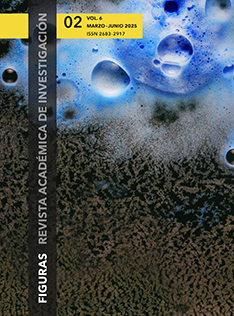Anxieties of the Anthropocene in R´lyeh and Palmyra atoll; the nautical weird fiction of Lovecraft and D.T. Neal
DOI:
https://doi.org/10.22201/fesa.26832917e.2025.6.2.411Keywords:
Nautical weird fiction literature, monster, sublime, Anthropocene, Cthulhu, Lovecraft, D.T. NealAbstract
IN D.T. Neal’s 2013 novel Relict, the protagonist, Paige, witnesses how her pleasure trip across the Pacific aboard a revolutionary luxury yacht, comes to an end when her three companions are murdered by a giant octopus that holds her prisoner on a solitary atoll. As she prepares her final confrontation to escape the creature, she thinks of Cthulhu, H.P. Lovecraft’s octopus-faced creation. The reference to The Call of Cthulhu (1928) goes beyond this mere mention; in terms of the plot, both Lovecraft´s story and Neal’s coincide on the presence of three different evidences in each of the works, which make difficult to deny the existence of monstrous entities that give their respective titles to the narratives and whose irruption forces the protagonists to accept the existence of a broader reality where any humanity preponderance is completely overshadowed. Furthermore, the two stories take place in the vastness of the Pacific, which makes awareness of humanity's insignificant role on Earth even more evident. Also, the fact that creatures belong to lineages much older than that of primates. From the perspective of these beings, we humans are an irrelevant species, and our claim to supremacy on the planet is contested by their successful attacks, as they are better adapted to their environments and they are only monstrous from our perspective. The purpose of this chapter is to frame the definition of Nautical Weird / Literatura náutica de lo extraño emphasizing the role of the ocean’s immensity in the impression both protagonists experience in both texts when confronting creatures whose presence challenges human knowledge. Based on this, I will explore how Lovecraft and Neil make use of an encounter with oceanic monstrosities, whose perspectives ended up as opposite to anthropocentrism. Through these encounters, both authors express similar concerns regarding the Anthropocene, despite the almost century-long gap between their writings.Downloads
References
Cohen, Margaret. 2012. The Novel and the Sea. Princeton, New Jersey: Princeton University Press
Fisher, Mark. 2017. The Weird and the Eerie. London: Repeater Books
Hamilton, Bonneuil y François Gemenne eds. 2015. “Thinking the Anthropocene.” In The Anthropocene and the Global Environmental Crisis: Rethinking Modernity in a New Epoch. New York: Routledge
Harman, Graham. 2018. Object-Oriented Ontology: A New Theory of Everything. London: Pelican Books
Jarvis, Timothy. 2017. “The Weird, the posthuman, and the abjected world-in- itself: fidelity to the ‘Lovecraft Event’ in the work of Caitlín R. Kiernan and Laird Barron.” Textual Practice, DOI: 10.1080/0950236X.2017.1358693.
Lovecraft. H. P. 2000a. The Annotated Supernatural Horror in Literature. New York: Hippocampus Press
Lovecraft. H. P. 2000b. Lord of a Visible World: An Autobiography in Letters, Edited by S.T. Joshi, and David E. Schultz. Athens, Ohio: Ohio University Press
Lovecraft. H. P. 2014. The New Annotated H. P. Lovecraft., Edited by Leslie S. Klinger. Nueva York: W.W. Norton & Company
Luckhurst, Roger. 2017. “The Weird: A Dis/orientation.” Textual Practice 31, no.6 (September): 1041-1061, DOI https://doi.org/10.1080/0950236X.2017.1358690
Miéville, China. 2009. “Weird Fiction.” In The Routledge Companion to Science Fiction. Edited by Mark Bould, Andrew M. Butler, Adam Roberts, and Sherryl Vint. New York: Routledge
Morton, Timothy. 2010. The Ecological Thought. Cambridge, Massachusetts: Harvard University Press
Morton, Timothy. 2016. Dark Ecology: For a Logic of Future Coexistence. New York: Columbia University Press
Neal, David T. 2013. Relict. Chicago: Nosetouch Press
Packham, Jimmy and David Punter. 2017. “Oceanic Studies and the Gothic Deep.” Gothic Studies 19, no. 2 (November): 17-29. https://doi.org/10.7227/GS.0026
Quigley, Claire. 2017. “The Weird in Fantastika: Grotesque Aesthetics and Disrupting Anthropocentricism.” Fantastika Journal 1, no. 1 (April): 54-72. https://www.fantastikajournal.com/publications
Steffen, Crutzen, and John R. McNeill. 2007. “The Anthropocene: Are Humans Now Overwhelming the Great Forces of Nature?” Ambio: a Journal of the Human Environment 36, no. 8 (December): 614-621. https://doi.org/10.1579/0044-7447(2007)36[614:TAAHNO]2.0.CO;2
Thacker, Eugene. 2010. After Life. Chicago: The University of Chicago Press
Ulstein, Gry. 2019. Age of Lovecraft?’—Antrhropocene Monsters in (New) Weird Narrative”. In Nordlit 42: Manufacturing Monsters. Edited by Christian Beyer, Juliane C. Bockwoldt, Emil Lundeal Hammar, and Holger Pötzsch. (Autumn): 47-65. DOI https://doi.org/10.7557/13.5004
Williams, Wendy. 2022. Kraken: The Curious, Exiting and Slightly Disturbing Science of Squid. New York: Abrams and Chronicle Books.
Downloads
-
Abstract 39
-
PDF (Spanish) 17
-
Visor XML (Spanish) 2
-
ePub (Spanish) 12
Published
Issue
Section
License
Copyright (c) 2025 Antonio Alcalá-González

This work is licensed under a Creative Commons Attribution-NonCommercial-ShareAlike 4.0 International License.
All works published in FIGURAS REVISTA ACADÉMICA DE INVESTIGACIÓN are subject to an Attribution-NonCommercial-ShareAlike 4.0 International license. Authors are owners of their articles and can republish them in other media, provided that they communicate it to the editors and indicate the texts were originally published in FIGURAS REVISTA ACADÉMICA DE INVESTIGACIÓN






















